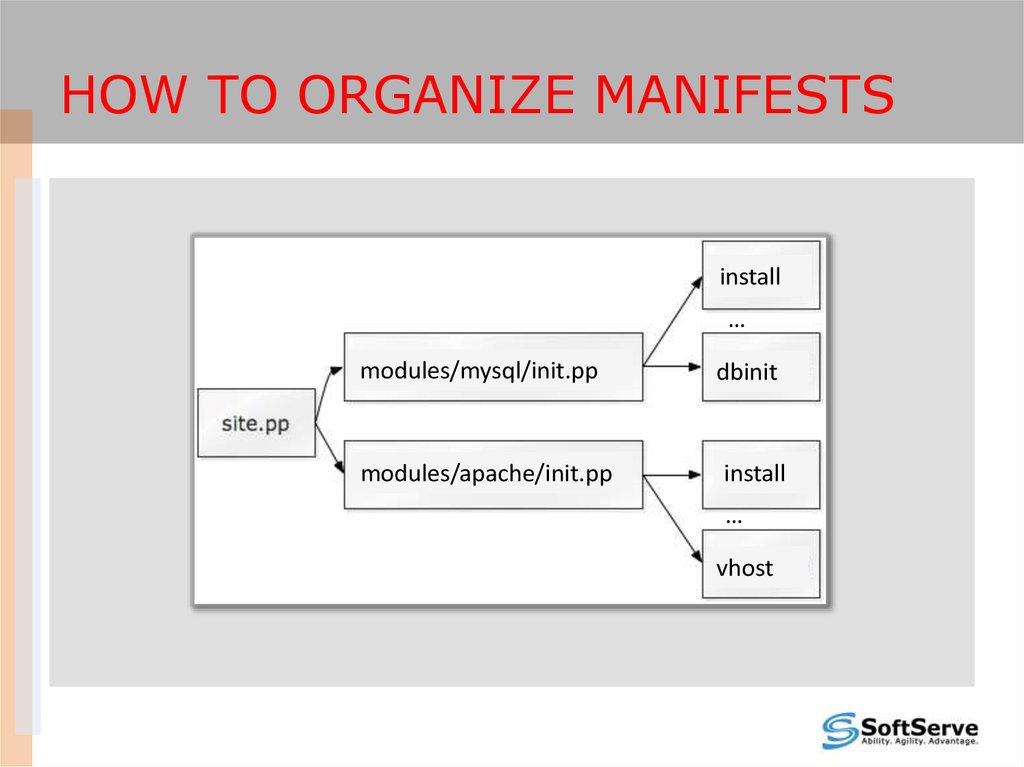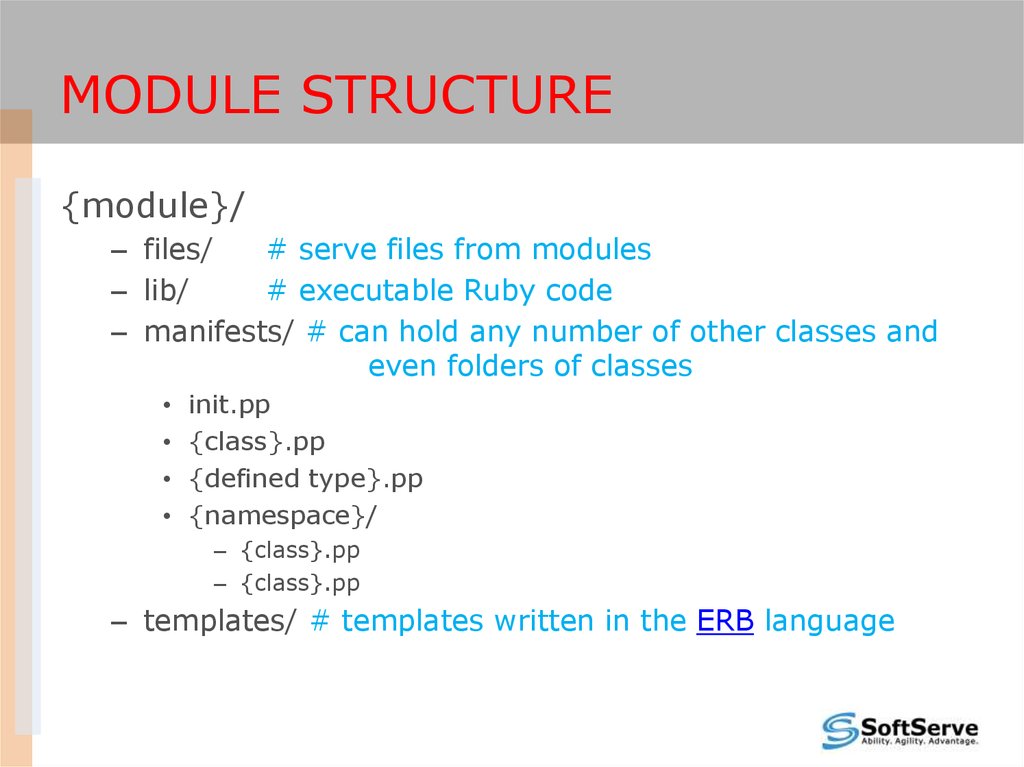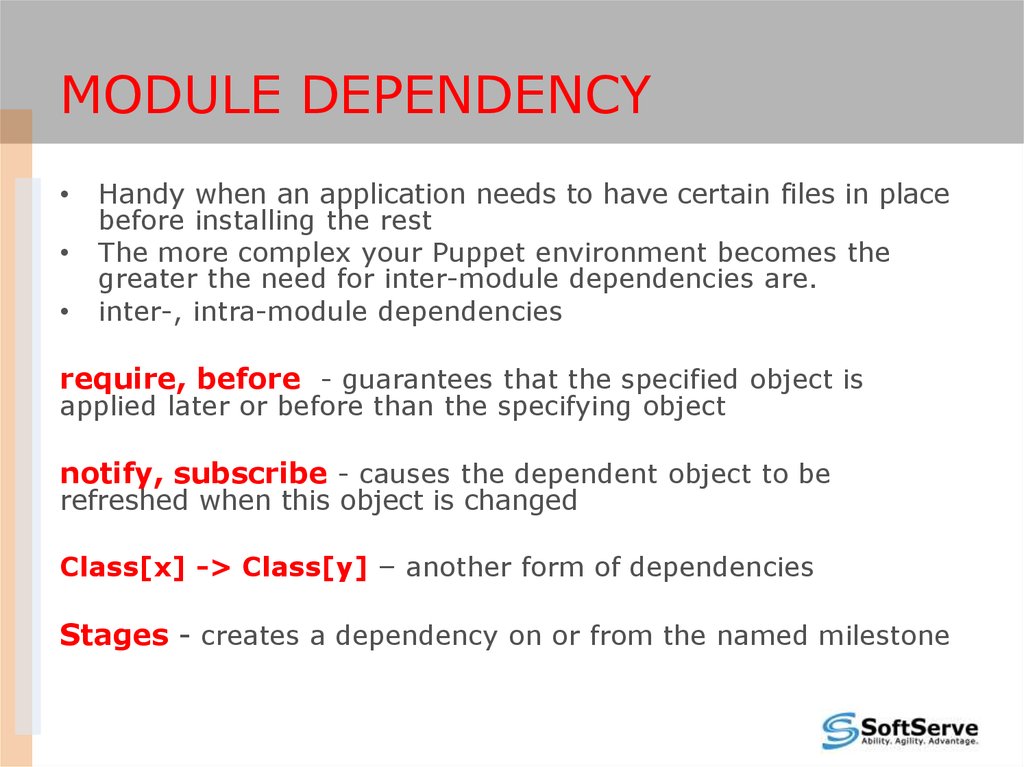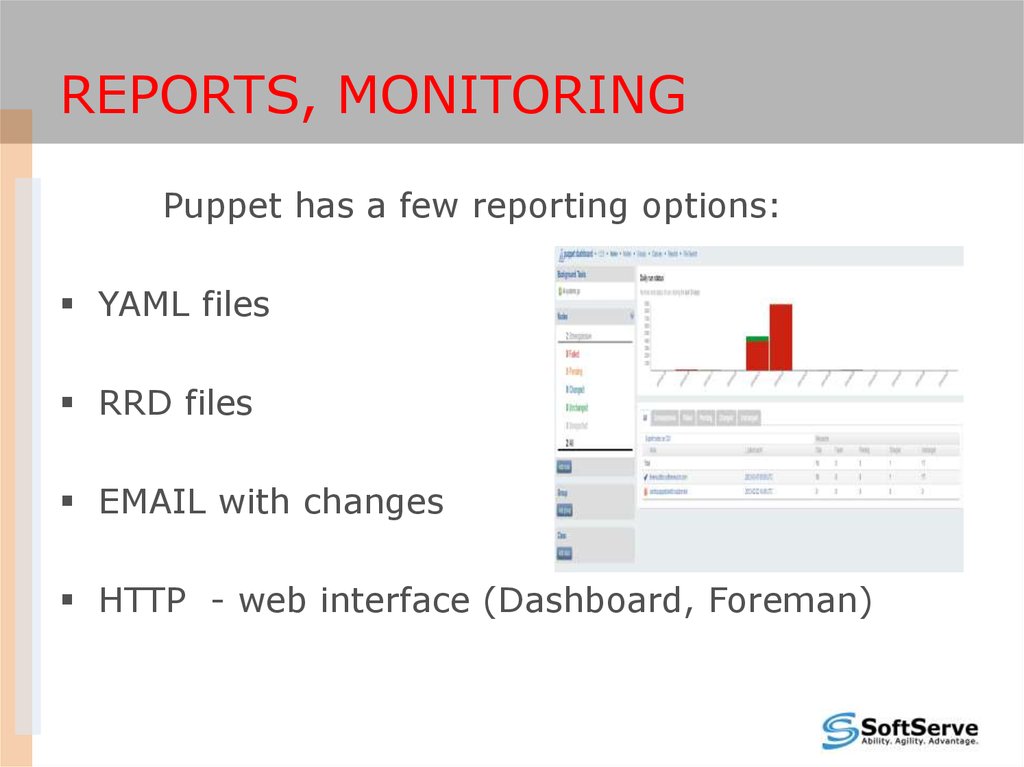Similar presentations:
Puppet – configuration management tool
1.
PUPPET – configurationmanagement tool
Vitaliy Sinyayev
2. CONTENT
PART I – GETTING STARTEDPART II – PUPPET INSIDE
PART III – DEPLOYMENT OF PUPPET
PART IV - SCENARIO OF DEPLOYMENT
WITH HELP OF PUPPET
3. PART I
GETTING STARTED4. Typical Sysadmin Job
TYPICAL SYSADMIN JOBRepetitive
Manual
Tedious
5. WHO HELPS US
-Automation
Unification
Accuracy
Reproducibility
Centralized auditing
Reduce time
Save money
6. What is PUPPET ?
configuration management toolopen source
Ruby-based system
relying upon client-server model
used to manage throughout lifecycle IT systems:
7. PUPPET’S BENEFITS
- Large developer base- Optimized and easier configuration language
- Better documentation
- Abstracted from underlying OS (more platform
support)
- Easily scalable and customizable
- Large installed base (Google, Siemens, Red Hat,
Cisco)
8. PART II
PUPPET INSIDE9. Puppet MODEL
PUPPET MODELDeployment
Configuration Language
Resource Abstraction Layer
Transactional Layer
Usually Client-Server
Describe
How to apply
Compile
Communicate
Apply
Report
10. PUPPET DEPLOYMENT MODEL
Client-serverMaster/
CVS/SVN
server
Single (no master)
Request;
reports
CVS/SVN
client
Master - store & compile
configs
Client - apply & compile
configs locally
Agent - pull
configuration
from master
CVS - just as repo for
configs
11. PUPPET DEPLOYMENT MODEL (comparison)
Client-serverSingle (no master)
+ better security
+ no bottleneck of
master
+ no single point of
failure
+ no PKI
+ advanced
management
+ authorization
+ centralized execution
- huge load on server
- single point of failure
- no advanced features
- loss in security
- loss ease of
management
12. Architecture of Puppet
ARCHITECTURE OF PUPPETTCP port
8140
Manifest (code of
scenario)
Server
Puppet
master
compile on server
catalog
CA/SSL
cert
HTTPS/SSL
connection
Client
apply
Puppet
agent
Provider
Facter
13. Main components of Puppet system
MAIN COMPONENTS OFPUPPET SYSTEM
Server daemon:
– puppet master ( uses WEBrick web server)
– run as puppet user
– can force client to pull new configs – puppet kick
Client daemon:
– puppet agent
– run as root (pulling server every 30min defaults or from
cron)
Both have configuration file => puppet.conf
14. Main components of Puppet system (continued)
MAIN COMPONENTS OF PUPPETSYSTEM (continued)
Puppet’s Certificate Authority:
– puppet ca, cert
– SSL certificates
Provider
– apply packages management on hosts
Facter
– gathers basic information about node’s hardware and
operation system
15. Elements of Puppet system
ELEMENTS OF PUPPET SYSTEMManifests (code on puppet/ruby language) on server => *.pp
use some programming methods: variables, conditional
statements, functions
Resources (types) is a particular element that Puppet knows how
to configure
Classes and defines basic named collection of resources
Providers specific implementation of a given resource type
Templates apply code and variable substitution
Modules collection of manifests, files, plugins, classes, templates
and so on
Nodes – machines being configured, identified generally by its
hostname
Files, facters, libs, functions and so on
16. Elements of Puppet system
ELEMENTS OF PUPPET SYSTEMmanifest
CLASS
RESOURCE
(file)
TEMPLATES
FILES
RESOURCE
(user)
are used in manifests
MODULE
apply
NODE
LIBS (facter,
provider, function
…)
17. Puppet Infrastructure
PUPPET INFRASTRUCTURE/etc/puppet
auth.conf
files/
autosign.conf
byhost/
fileserver.conf
host1/
puppet.conf
host2/
tagmail.conf
host3/
manifests/
nodes.pp
site.pp
classes/
class1.pp
class2.pp
Files
Folders
modules/
mod1/
manifests/
init.pp
files/
templates/
18. PART III
DEPLOYMENT OF PUPPET19. Procedure of deployment
PROCEDURE OF DEPLOYMENT• Setup (master and clients)
• Set up configuration files
• Deploy certificates
• Write and deploy manifest and describe nodes
20. Installation of Puppet
INSTALLATION OF PUPPET• Most platforms will use the default package
manager to install Puppet or from source
• Prerequisites: ruby, ruby-libs, facter
21. Sample Puppet config file
SAMPLE PUPPET CONFIG FILECan be configured via CLI or configuration file
[main]
vardir = /var/lib/puppet
logdir = /var/log/puppet
ssldir = $vardir/ssl
moduledir = /var/lib/modules
[agent]
server = <ip or dns name>
localconfig = $vardir/localconfig
report = true
[master]
reports = http
autosign = /etc/puppet/autosign.conf
22. Setup Certificate
SETUP CERTIFICATEMultiple ways to resolve this
1. Setup puppetmaster to automatically sign certificates
2. Setup puppetmaster to pre-sign certificates
3. Perform manual certificate signing each time
23. Auto Certificate signing
AUTO CERTIFICATE SIGNINGSetup automatic certificate signing you must specify so
in the /etc/puppet/autosign.conf file:
*.sample.domain.com
server1.sample.domain.com
+ will automatically sign certs
– security risk, not good to automate the certificate
signing mechanism
24. Pre-signing certificates
PRE-SIGNING CERTIFICATESGenerate a pre-signed certificate for clients:
puppet cert --generate client1.example.com
Transfer the private key, the client certificate, the CA
certificate to the new client:
/etc/puppet/ssl/private_keys/client.pem
/etc/puppet/ssl/certs/client.pem
/etc/puppet/ssl/certs/ca.pem
+ better controlled security
– have to provide transferring
25. Manual certificate signing
MANUAL CERTIFICATE SIGNINGDoesn’t require the autosign.conf file
List of the waiting requests on the puppetmaster by using:
#
puppet cert --list
server1.sample.domain.com
server2.sample.domain.com
to sign a specific request run the following:
# puppet cert --sign
server1.sample.domain.com
+ most secure way to sign certificates
– can get cumbersome when scaling your puppet installation
26. Create manifest and Describe Node
CREATE MANIFEST ANDDESCRIBE NODE
Create main manifest in /etc/puppet/manifests/site.pp
Node definitions can be defined:
– configuration block matching a client in manifest
– outside of puppet - LDAP, external script
node default { include <module>….}
node “www.domain.com” { …}
node /^www\.\w+\.com/ { … }
expression
# can use regular
27. Create manifest and Describe Node (continue)
CREATE MANIFEST ANDDESCRIBE NODE (CONTINUE)
node default {
user {"testpup":
ensure => present,
shell => "/sbin/nologin",
home => "/nonexistent",
password => "test",
}
}
28. PART IV
SCENARIO OF DEPLOYMENTWITH HELP OF PUPPET
29. WORKSHOP (LIVE EXAMPLE)
TASKAPACHE SERVER
(main address - 192.168.30.20:80 only)
APACHE VIRTUAL HOSTS
ER
( 192.168.166.84:3080)
(192.168.166.84:4080)
……..
with PUPPET
agent installed
(freesvv)
WHAT WE HAVE
WHAT FEATURES WE USE
=>
PUPPET
MASTER
(puppetbig2)
modules, classes, class-definitions, templates
RESULT ??????
30. How to organize manifests
HOW TO ORGANIZE MANIFESTSinstall
…
modules/mysql/init.pp
dbinit
modules/apache/init.pp
install
…
vhost
31. Root manifest - SITE.PP
ROOT MANIFEST - SITE.PPGlobal master manifest is site.pp which typically
defines the node types puppet can configure
node ‘server1’ {
include pkg-mgmt
include apache
}
node ‘server2' {
include apache
include mysql
}
# use module
32. Building module
BUILDING MODULEStoring modules separately in
/…/…/modules/module_name assists in management
We can store module specific files within the module
instead of all together
Inside each module, we have several directories:
manifests, files, templates, plugins
The manifest is where the module’s definition lives
and starts - “init.pp”
33. Module structure
MODULE STRUCTURE{module}/
– files/
# serve files from modules
– lib/
# executable Ruby code
– manifests/ # can hold any number of other classes and
even folders of classes
init.pp
{class}.pp
{defined type}.pp
{namespace}/
– {class}.pp
– {class}.pp
– templates/ # templates written in the ERB language
34. Module start file - init.pp
MODULE START FILE - INIT.PP# main class
require apache::params
# class dependencies
case $operatingsystem { # variable
class apache {
FreeBSD: { include apache::install }
Centos: { include apache::instyum }
}
include apache::service
}
Can use variables, conditional statements;
Call new subclasses
Convenient way – organize special class(subclass) for
variables
35. Subclass for Install
SUBCLASS FOR INSTALLclass apache::install {
file { $apache::params::install_option: # resource - type of file
ensure => directory,
recurse => true,
recurselimit => 1,
owner => "root",
group => "wheel",
mode => 0644,
source => "puppet:///modules/apache/install",
}
package { $apache::params::apache_pkg_name: # resource - type of package
provider => portupgrade,
ensure => installed,
require => File[$apache::params::install_option],
}
}
Each resource has its own parameters & properties
More about resources:
http://docs.puppetlabs.com/references/stable/type.html
36. Subclass for SERVICE
SUBCLASS FOR SERVICEclass apache::service {
service { $apache::params::apache_ser_name:
ensure => running,
hasstatus => true,
hasrestart => true,
enable => true,
require => [Class["apache::install"],
File["$apache::params::apache_main_conf"]]
}
file { $apache::params::apache_main_conf:
ensure => present,
owner => 'root',
group => 'wheel',
mode => '644',
source => "puppet:///modules/apache/config/httpd.conf_free",
require => Class["apache::install"],
notify => Service["$apache::params::apache_ser_name"],
}
}
37. Module Dependency
MODULE DEPENDENCYHandy when an application needs to have certain files in place
before installing the rest
The more complex your Puppet environment becomes the
greater the need for inter-module dependencies are.
inter-, intra-module dependencies
require, before - guarantees that the specified object is
applied later or before than the specifying object
notify, subscribe - causes the dependent object to be
refreshed when this object is changed
Class[x] -> Class[y] – another form of dependencies
Stages - creates a dependency on or from the named milestone
38. Definitions
DEFINITIONSDefinitions are similar to classes, but they can be instantiated multiple times
with different arguments on the same node (looks like functions for
resources)
define apache::vhost ( $port, $docroot, $template='apache/vhosts.erb’) {
file { "/etc/apache2/sites-available/$name":
content => template($template),
owner => 'root',
group => 'wheel',
mode => “644’, }
}
-----------------------------------------------------------------------------------------Example of usage
node ‘www’ {
include apache
apache::vhost { ‘www-second':
port => 80,
docroot => '/var/www/www-second',
template => ‘apache/www_vhosts’,
}
}
39. Templates
TEMPLATESTemplates are flat files containing Embedded Ruby (ERB)
variables
Allows you to create template configuration files
NameVirtualHost *:<%= port %>
<VirtualHost *:<%= port %>>
ServerName <%= name %>
DocumentRoot <%= docroot %>
<Directory <%= docroot %>>
AllowOverride None
</Directory>
ErrorLog /var/log/apache2/<%= name %>_error.log
CustomLog /var/log/apache2/<%= name %>_access.log combined
</VirtualHost>
<%= … %> - variable field
40. Custom facter
CUSTOM FACTERSystem inventory tool on client
Can be used as variables in manifests
You can add custom facts as needed
Examples of facters:
domain => soft.com
fqdn => puppetclient.soft.com
hostname => puppetclinet
ipaddress => 172.20.88.132
Steps to create custom facts:
- create file in module directory
../module_name/lib/facter/<name>.rb
- write code on Ruby
- enable on client and server – “pluginsync=true”
41. Reports, monitoring
REPORTS, MONITORINGPuppet has a few reporting options:
YAML files
RRD files
EMAIL with changes
HTTP - web interface (Dashboard, Foreman)
42. CONCLUSIONS
What is the profit ?Quick and flexible deployment of our complicated
system in production
Quick re-deployment of existing system in case of
failure (previously generating data backups)
Easy deployment of huge numbers of servers
Easy generation and modification of configuration files
43. Additional resources for PUPPET
ADDITIONAL RESOURCES FOR PUPPEThttp://docs.puppetlabs.com/guides/
http://rubular.com/
http://github.com/puppetlabs/
http://forge.puppetlabs.com/
Book “Pro Puppet” by James Turnbull,
Jeffrey McCune
Book “Puppet 2.7 Cookbook” by John
Arundel











































 programming
programming software
software








